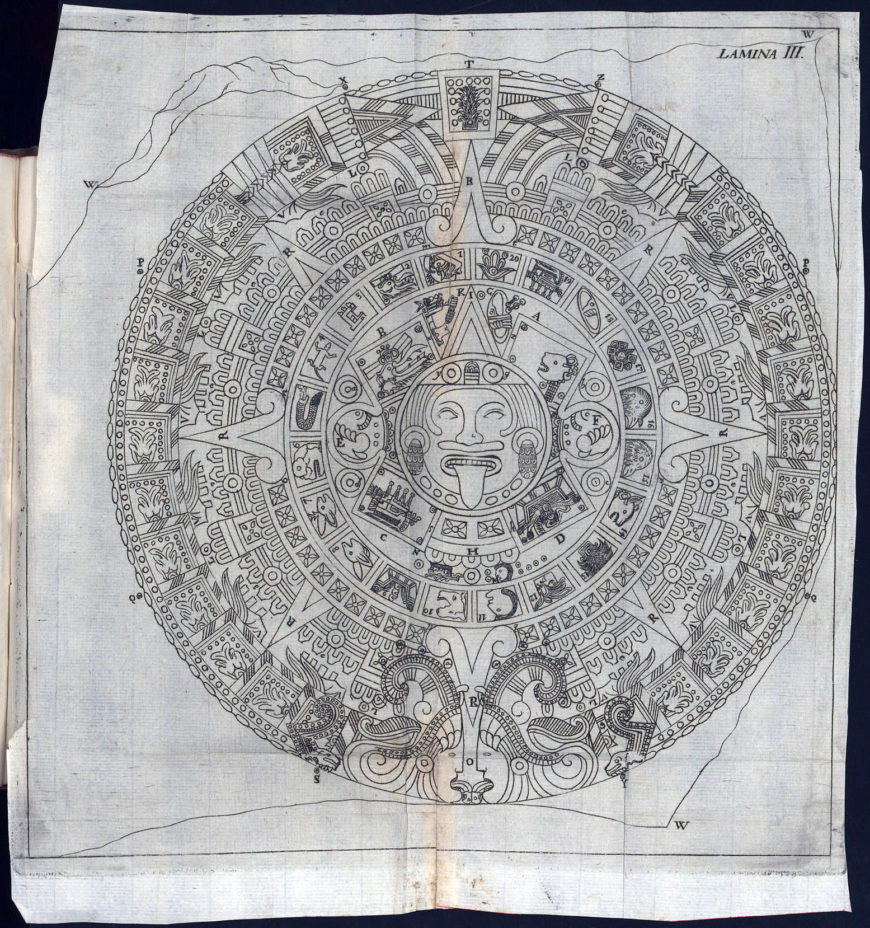
Drawing of the Aztec Sun Stone, which carries references to the Aztec calendar, from Antonio de León y Gama, Descripción histórica y cronológica de las dos piedras que con ocasión del nuevo empedrado que se está formando en la plaza principal de México, se hallaron en ella el año de 1790..., 1792 (Library of Congress)
We think of calendars as utilitarian—as tools that we all use every day to organize our time. But calendars also tell us a great deal about how the cultures that produce and use them understand and structure their world.
Before Spanish conquerors invaded the Americas in the fifteenth and sixteenth centuries, the Indigenous peoples of ancient Mexico, Guatemala, Belize and Honduras—an area known today as Mesoamerica—developed cultures over more than three millennia that were distinctive but that also held many ideas in common. Some of the features that they shared include the presence of ballcourts where a game was played using a heavy rubber ball, the development of complex religions with elaborate pantheons of deities, and, in works of art, a shared understanding of the importance of materials like greenstone and precious feathers.
Many Mesoamerican cultures also shared common ways of counting time. Calendars consisted of a system of two different counts that ran simultaneously. The first count tracked a cycle of 260 days (in Nahuatl, the language of the Nahua ethnic group, this was called the tonalpohualli), which was used for divining an individual’s fate (or predicting their future); that fate was itself understood as a portrait of an individual’s character. The other count, closer to our solar year, followed a cycle of 365 days (in Nahuatl, the xiuhpohualli); this calendar tracked the passage of the alternating wet and dry seasons. Calendars were central to Mesoamerican cultures because they were tied to major seasonal cycles, and related to ideas around individuals and their fates.
Works of Mesoamerican art often include references to calendars and time. Taking a closer look at the role of the calendar in different artistic contexts helps us to understand how knowledge about time was represented and utilized in the ancient world.
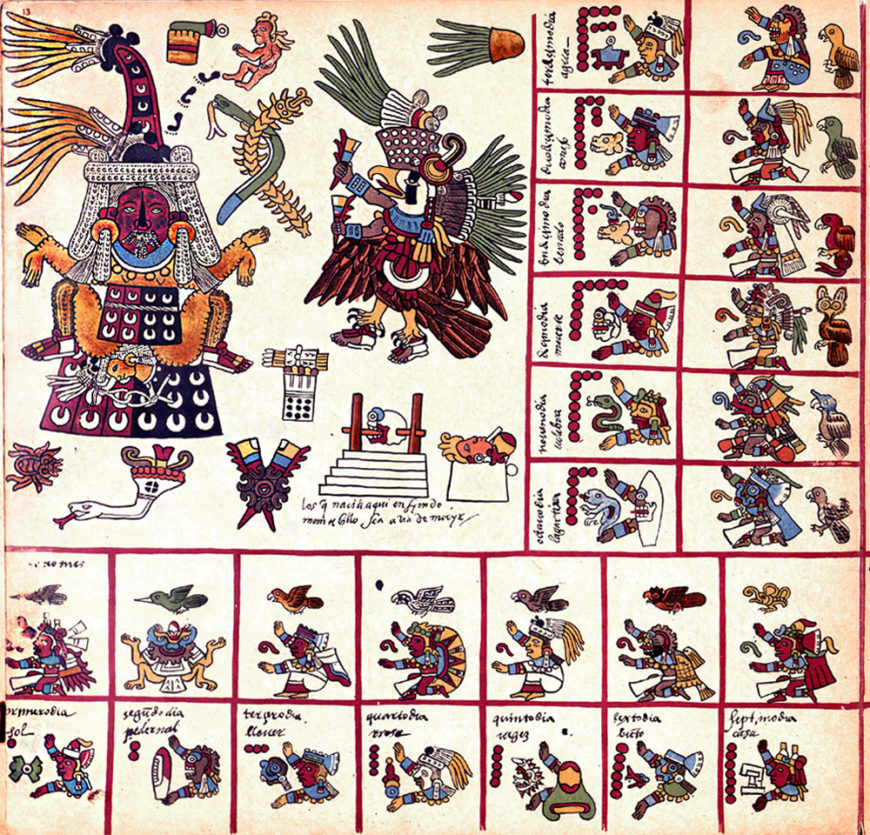
This page from an almanac in the Codex Borbonicus represents a 13-day period from the 260-day calendar used for divination in the Mesoamerican world. Codex Borbonicus, p. 13, early 16th century, paint on amate bark paper (Bibliothèque de l’Assemblée Nationale)
Painting the ritual calendar
Painted books—known today as codices, or codex in the singular—created both before and after the arrival of Spaniards to Mesoamerica in 1519 give us an idea of how the 260-day ritual count (the count most closely related to divination and prognostication) was represented in Mesoamerican art.
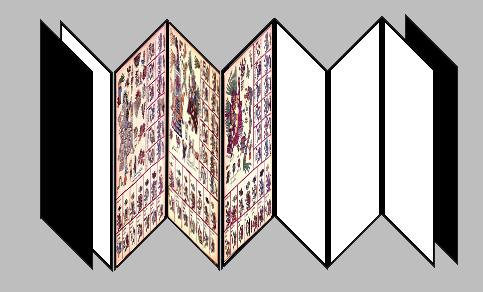
The accordion-fold format common to Indigenous Mesoamerican codices
In the first half of the sixteenth century, a painted book (today known as the Codex Borbonicus) was created in Central Mexico using a very long strip of bark paper folded in an accordion-like format. This book was likely similar to the books typical of Mexica (sometimes called Aztec) visual culture, a tradition that flourished in Central Mexico in the fifteenth and sixteenth centuries.
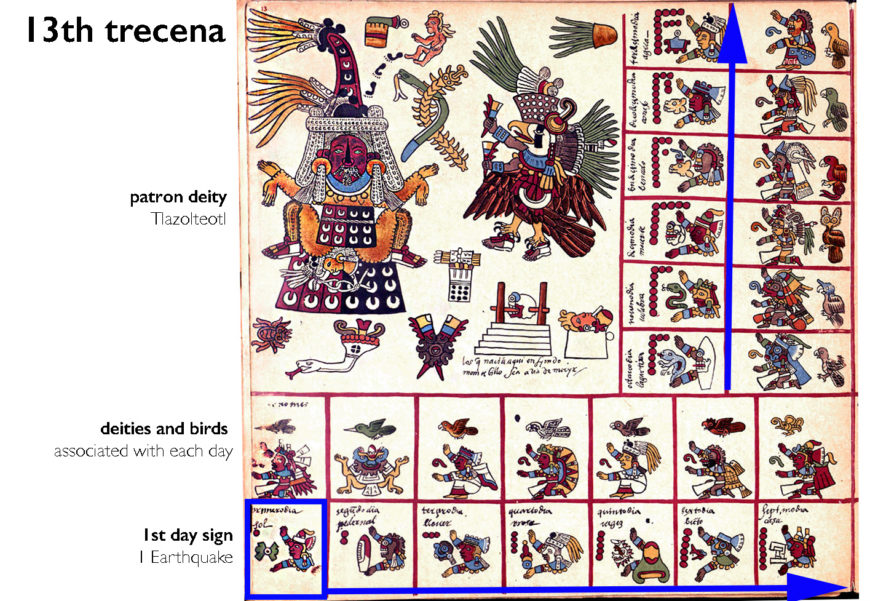
The 13th trecena. Codex Borbonicus, p. 13, early 16th century, paint on amate bark paper (Bibliothèque de l’Assemblée Nationale)
One page from an almanac in the Codex Borbonicus represents a 13-day period (called a trecena), and each trecena had a presiding patron deity. Calendar specialists consulted images like these to interpret whether the individual days that were represented might portend good, evil, or ambiguous fates. The first section of the Codex is dedicated to these 20 months of 13 days that made up the 260-day calendar.
Let us take a close look at the 13th trecena. This complex image consists of two parts, including both the count of days in the ritual calendar and the deities who were associated with those days. In the grids that run along the sides of the page, the artist has painted a sequence of 13 glyphic signs representing each of 13 days; the count starts at the bottom left and ends and the top right. 1 Earthquake is the first day of this period.
Meanwhile, the larger space on the page is a cartouche where we see the gods who are associated with these days. On the left, a frontally oriented female deity (Tlazolteotl) is depicted in the position of giving birth, while the deity on the right is an avian god who holds two perforators for sacrifice. These gods are surrounded by insects like the spider and centipede (creatures associated with night and darkness) and by objects, like an incense burner and perforators.
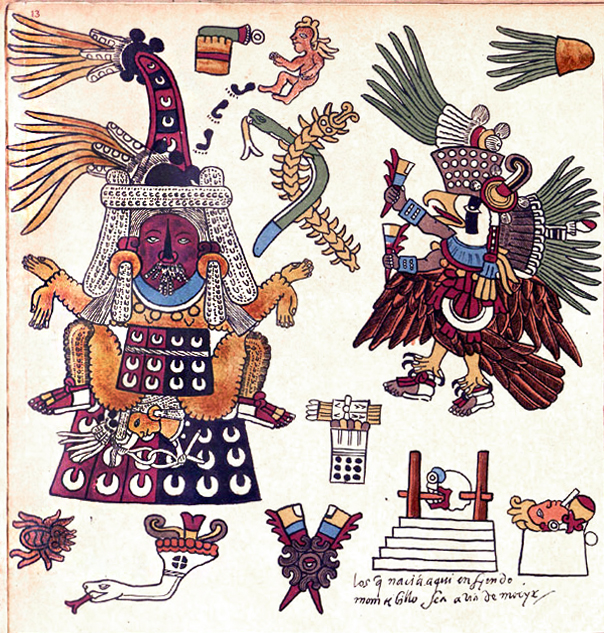
Codex Borbonicus, detail of 13th trecena with Tlazolteotl, p. 13, early 16th century, paint on amate bark paper (Bibliothèque de l’Assemblée Nationale)
When a calendar specialist consulted this painting, these images of deities, animals, and objects could be interpreted to understand the fates and characters associated with the set of days referenced in the painting. Each day in the 260-day count was associated with a distinct quality or fate. Some days were believed to be tied to good outcomes and good character; others were ambiguous, and others still predicted evil ends. These destinies also spoke to the identity of people born on those dates. The birthdate of a child was considered in a number of contexts to be intimately tied to their fate, and in some contexts, like in the Mixtec tradition from southern Mexico, individuals were named after their birthdates, speaking to the close tie between the calendar and identity.
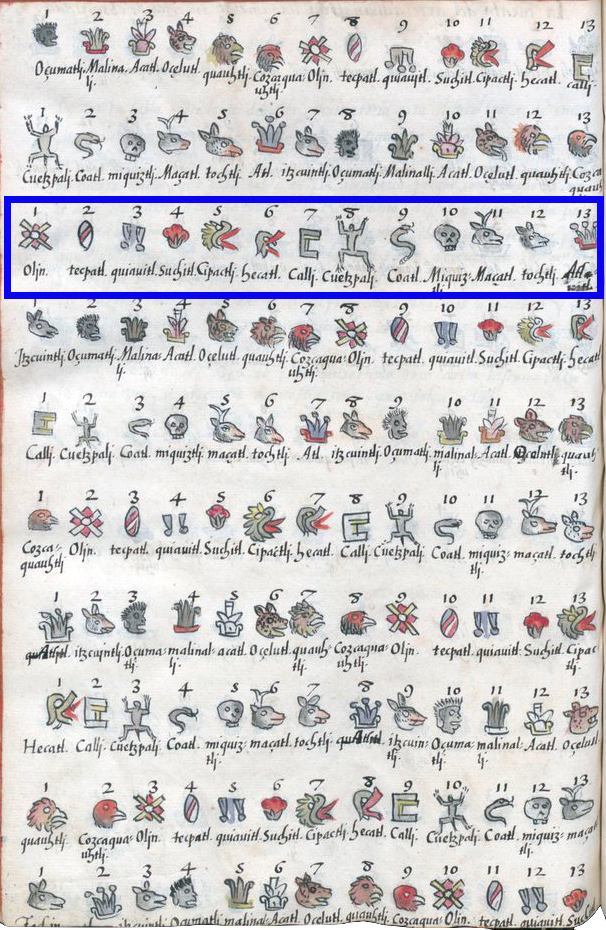
Trecena day signs, including the 13th trecena in the blue box. Bernardino de Sahagún and Indigenous collaborators, General History of the Things of New Spain, also called the Florentine Codex, vol. 1, book 4, 1575–1577, watercolor, paper, contemporary vellum Spanish binding, open (approx.): 32 x 43 cm, closed (approx.): 32 x 22 x 5 cm (Medicea Laurenziana Library, Florence, Italy)
Today, we have some idea of how a painting like this one might have been interpreted in the Aztec world thanks to the texts in a manuscript known as the Florentine Codex. This manuscript was created in the second half of the sixteenth century, after the Spanish Conquest, when the Franciscan friar Bernardino de Sahagún asked a number of Nahuatl-speaking Indigenous collaborators to explicate various facets of Nahua thought and history, including their ideas about the calendar. When these collaborators turned to describe the ritual period depicted in the above page of the Codex Borbonicus, they wrote that those born on these days had destinies that were “only half good. He who was then born, man or woman, who did penance well, who took good heed, who was well reared, succeeded and found his [rewards]. But if he did not take good heed, and were not well reared, the opposite resulted. He met misery […]”[1] In this case, the fate of the days in the painting was ambiguous. It might portend either a good or bad fate, depending on the actions taken by the person who was born then.
The solar calendar’s festivals
While the 260-day ritual calendar was used for understanding individuals’ fates, the 365-day count tracked the passage of time and the seasons of the solar year. In Aztec culture, the distinctive seasons of the year were times for different activities. During the rainy season, Aztec culture emphasized agricultural fertility and rites to propitiate gods related to water and sustenance. During the subsequent dry season, warfare and the expansion of the empire became major concerns. The 365-day solar calendar was divided into shorter 20-day periods (with 18 months total) when festivals were celebrated that were related to these seasonal concerns. The names of these 20-day periods speak to the character of the seasons: One period is named Toxcatl, “dryness,” and another is called Atlcahualo, “the ceasing of the waters.”

Celebrants unwrap tamales for a feast marking the festival of Atemoztli, “Descent of the Waters,” from the 365-day solar calendar. Detail from Codex Durán folio 342r, 1575, ink and wash on European paper (Biblioteca Nacional de España, Madrid)
In manuscript paintings made late in the sixteenth century, we find images that depict the festivals that were scheduled according to the 365-day solar calendar. Images of these rites appear in the manuscript known as the Codex Durán. These images were painted by Indigenous artists around Mexico City in the year 1575 and the text was written by the Dominican friar, Diego Durán. One painting shows how an Indigenous artist living in the colonial world depicted the ancient festival from the period of Atemoztli, a name that means “the descent of the waters.” In the painting, a group gathers upon a woven mat to eat tamales, the customary food for the celebration of this festival; the descending male figure at the top of the painting may represent the rains. Feasting was an important rite for this festival from the solar calendar; Codex Durán tells us that the tamales that the celebrants eat were considered offerings to ensure good rains and a good harvest. Unlike in the case of the Codex Borbonicus, this painting probably does not follow the format of an ancient book, since pre-Conquest references to the twenty-day festivals do not tend to include ritual scenes combined with important information about the months in the clouds. But it does show us how Indigenous artists imagined one of the festivals surrounding the agricultural cycle from the vantage point of their Colonial context.
The origins of the calendar
Manuscripts like the Codex Borbonicus and the Codex Durán show us how the calendar was visualized in the sixteenth century, but Mesoamerican calendars were in use long before that. We do not know exactly when the counts of the calendar were first adopted in Mesoamerican history, but archaeology tells us that the calendar’s past lies deep in the region’s history. On ancient stone monuments, solar calendar inscriptions appear by the first century B.C.E. in the region of Mexico’s Gulf Coast; in Oaxaca, inscriptions have been found that may date earlier still.
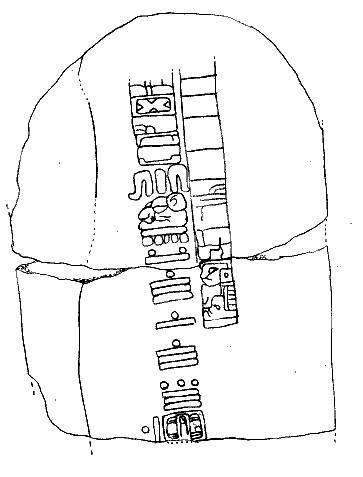
Stela C from the site of Tres Zapotes in Veracruz, Mexico, features one of the oldest calendrical inscriptions from Mesoamerica; it names a year that corresponds to 31 B.C.E. (CC0)
One of the oldest Mesoamerican monuments with a calendrical text is a sculpture from the site of Tres Zapotes, and it includes an inscription that notes the date of 31 B.C.E. Looking closely at its inscription, the left-hand column includes a series of numerals represented as dots above horizontal bars. This part of the text enumerates the number of days that have passed from a commonly held “start” point deep in time; the effect is that the inscription precisely names a single date that we are able to reconstruct today. Thanks to this count, we know exactly which historical moment was named in the inscription, and thanks to this monument, we appreciate the deep historical origins of calendrical monuments in Mesoamerica.
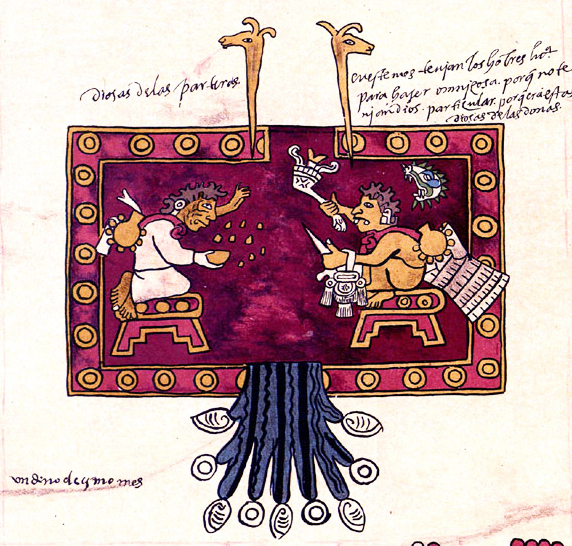
Detail of Oxomoco and Cipactonal, Codex Borbonicus, p. 21, early 16th century, paint on amate bark paper (Bibliothèque de l’Assemblée Nationale)
Although archaeology tells part of the story about the origins of the calendar, the Indigenous collaborators who created the Florentine Codex conveyed their ideas about the origins of the calendar. In their telling, the calendar had been invented by deities, including the feathered serpent known as Quetzalcoatl and a divine elderly couple named Oxomoco and Cipactonal; these elders are also named in other Nahuatl-language texts (including the manuscript known as the Anales de Cuauhtitlan). Indigenous peoples living in the colonial period had important beliefs about the sacred origins of the Mesoamerican calendar, beliefs that should be taken into account alongside contemporary archaeology’s story about the origins of the calendar.
Calendrical Inscriptions and Images of Power
Mesoamerican monuments show us that in some cases, calendrical information was deployed in support of images of power. This was the case in both the Maya and the Aztec worlds, where calendrical inscriptions contributed to visualizing the power of rulers.
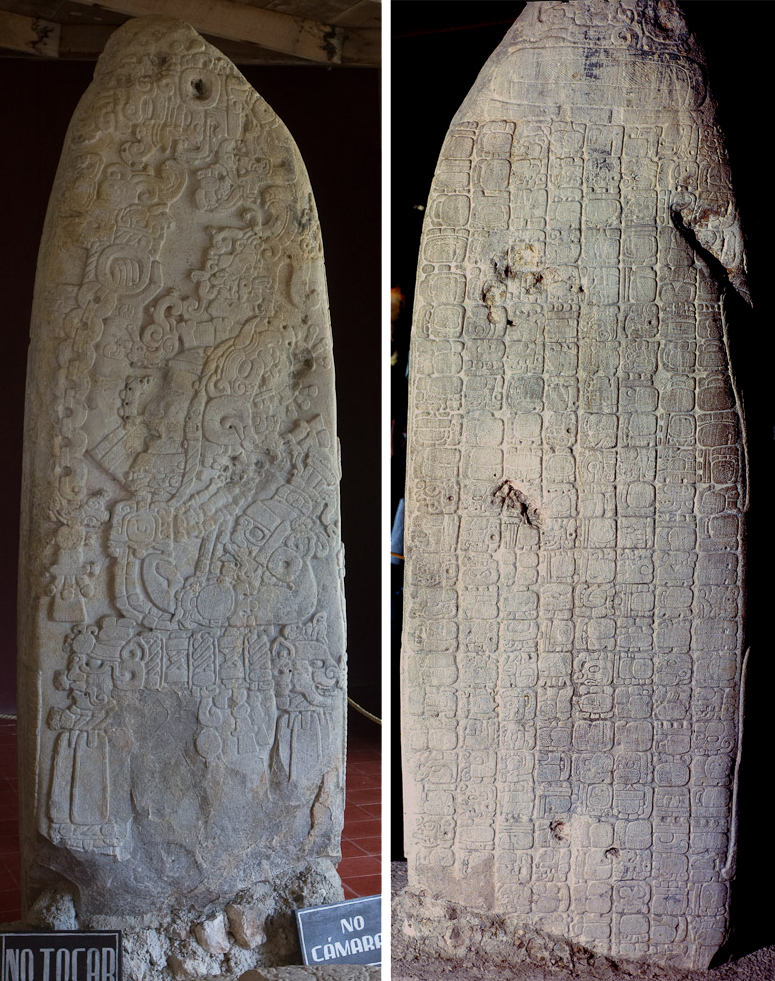
This fifth-century sculpture, Stela 31 from Tikal, Guatemala, represents the royal Siyah Chan K’awiil II dressed in elaborate finery; the back of the monument tells the story of generations of Tikal’s history using precise calendrical dates (photos: Left-Greg Willis, CC BY-SA 2.0; right-HJPD, CC BY 3.0)
In Classic Maya art, a tradition that flourished between 250 and 900 C.E., freestanding stone sculptures (known as stelae) were a surface where Maya scribes used calendrical inscriptions to record important moments in the lives of kings, such as the dates when they were born or when they ascended to the throne. This was the case on Stela 31 from the site of Tikal in northern Guatemala. Dedicated in the fifth century C.E., the front side of the monument depicts a king from Tikal named Siyah Chan K’awiil II. In the image, he appears covered in elaborate royal finery and accompanied by images referring to his lineage.
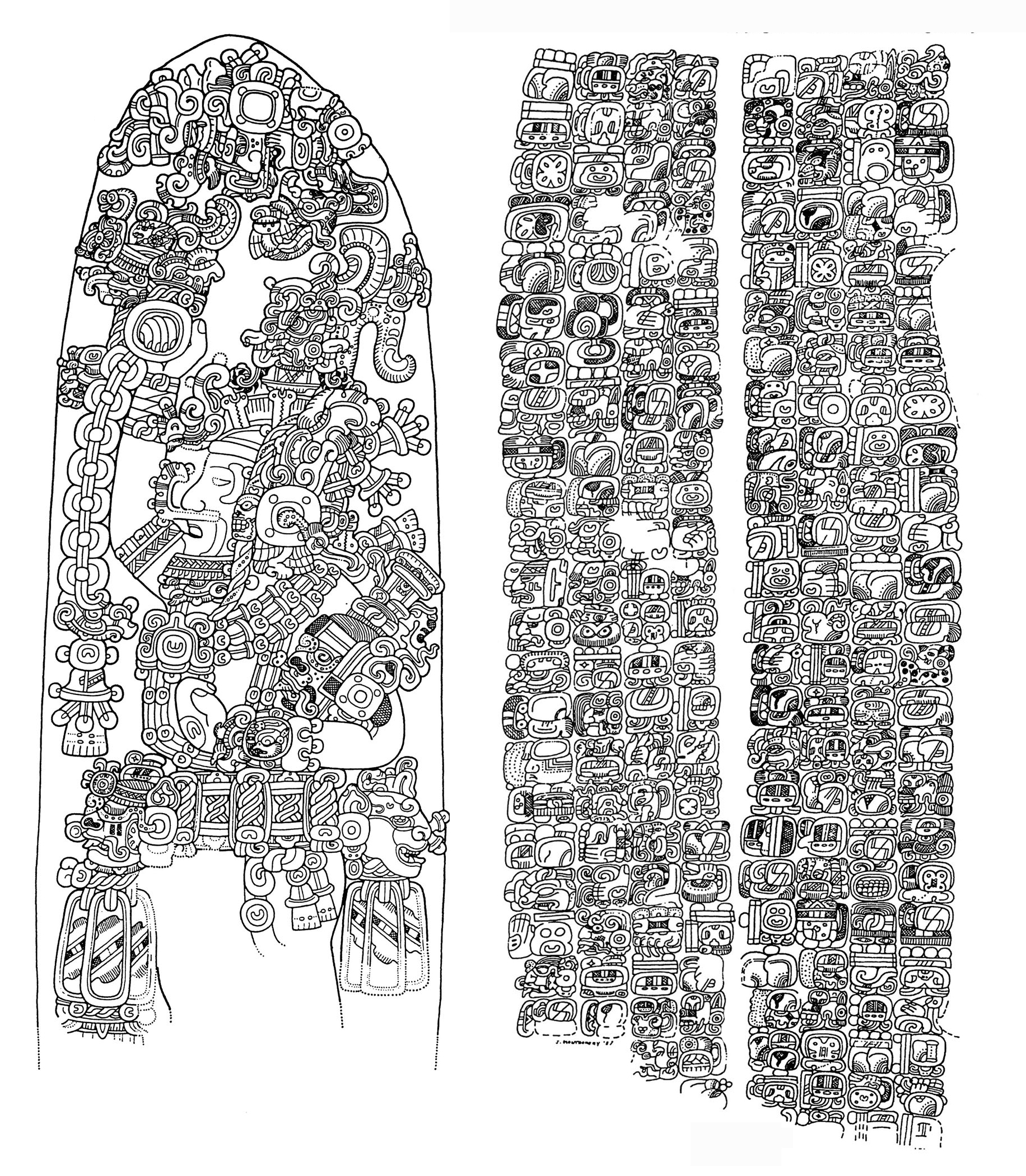
Stela 31 from Tikal, Guatemala (drawing © John Montgomery)
On the back of the monument, a long text describes episodes from Tikal’s history, from the moment when a foreign power took up leadership in the city in the previous century through Siyah Chan K’awiil II’s rise to the throne in 435, all the way to the moment when the stela itself was dedicated. Precise calendrical reckoning situated the events that led to Siyah Chan K’awiil II’s reign firmly in historical time and played an important role in constructing the king’s image and authority in this monumental work.

The Aztec Dedication Stone features a scene of a deceased king and his successor performing autosacrifice above a large date glyph corresponding to 1487–1488 (Museo Nacional de Antropología, Mexico City; left: Sarahh Scher, CC BY-NC-ND 2.0; right: Zach Lindsey, CC BY-SA 4.0)
Among the Aztecs, monumental calendrical inscriptions also played an important role in constructing a ruler’s power. The Aztec Dedication Stone represents an important ceremony of royal ritual autosacrifice carried out by a deceased ruler and his successor. At the top of the work, the ruler Ahuitzotl (seen at right) is shown with his royal predecessor Tizoc (left) performing autosacrifice, drawing streams of blood from their ears with sharp perforators. Their sacrificial blood feeds a hungry earth, represented as an upturned, open maw; Aztec religion involved sacrifices in which offerings were made to the earth to ensure that cosmic order was maintained. Below this scene, the sculptor depicted a very large calendrical inscription that dominates the entire composition, associating the ritual with the date 8 Reed (or 1487–1488). With the great visual weight given to this date, this politically potent monument and its concerns around succession and rule shows the importance of graphically foregrounding historical time in an image of royal power in Aztec art. Even so, time is also interestingly manipulated on this monument. Tizoc’s death before Ahuitzotl’s ascension suggests that the time imagined in the ritual scene is likely imaginary; what mattered instead was that the new ruler appear beside his predecessor, emphasizing his continuity with royal power.
Calendar after the Spanish Conquest
In the decades that followed the Spanish Invasion of the Americas, European missionary friars became interested in the Mesoamerican calendar because they sensed that it still held a powerful influence in the communities that they sought to convert to Christianity. In the Codex Durán, Diego Durán wrote that he suspected that an Indigenous town had adopted their patron saint because his feast day fell on an important day on the ancient calendar. [2] Since many of these friars believed that the practice of the ancient calendar was a way of maintaining idolatrous practices, missionaries sought to end the use of the Mesoamerican calendar altogether.
Despite Colonial efforts at extirpation, the calendar continued to constitute an important form of knowledge in some areas of Mesoamerica long after the Colonial period. Among K’iche Maya speakers in the Guatemala highlands, for example, specialists in Mesoamerican calendrical knowledge have continued to interpret and use the calendar in the twenty-first century as an integral part of their social and political milieu. The special place accorded to calendrical knowledge in these communities today speaks to the continued relevance of the Mesoamerican calendar into our own century, as well as the prestige and status accorded to the keepers of this vital form of understanding the world.




